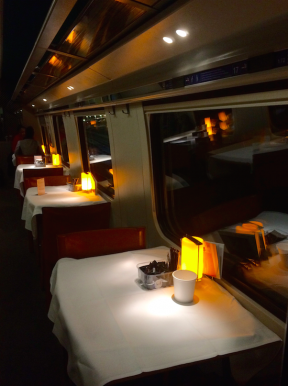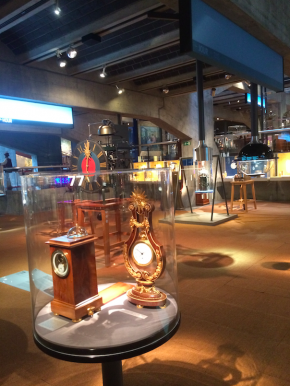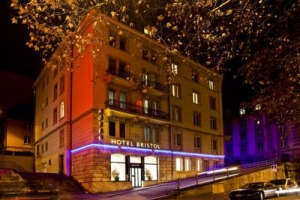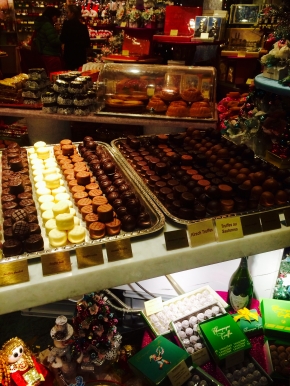Greentraveller's Winter Grand Train Tour of Switzerland
- Green Traveller

- Dec 4, 2015
- 11 min read
Updated: Feb 20, 2022
By Sian Lewis

I'm now back from my wonderful Grand Train Tour of Switzerland, using the Swiss Travel Pass to visit a huge range of places in 5 days by train, including the Swiss National Museum in Zurich, Montreux's Christmas Market, the wonderful GoldenPass train journey from Luzerne to Interlaken, the magnificent Grand hotel Suisse Majestic by the lake at Montreux, glacial skiing at Les Diablerets, the cheese train to Chateau D'Oex, and much more...
Thanks to all those who tweeted tips to Greentraveller on Twitter (using the hashtag #grandtraintour) and followed the trip on our other social media channels: Facebook, Google+ and Instagram (#grandtraintour).
Below is the timeline of my rolling blog of the trip:

Timeline of our Grand Tour of Switzerland:
Day 5 (Final day), Friday 4 December
1.30pm I leave for Geneva on the final train journey of my trip. It's raining heavily outside but the train is warm and cosy, and the restaurant carriage, lit by orange lamps, is a wonderful place to have a coffee and watch Lake Geneva, wreathed in fog, fly by.
11.30am: Mariki and I head to the Museum of Horology (entrance is free with my Swiss Travel Pass) in the centre of town. It's surprisingly well curated and lovely to explore, the gentle ticking and chimes of over 4,500 exhibits lulling the visitor into a sense of calm. The collection is a treasure trove, ranging from ancient water clocks used by the Egyptians to the very first pocket watches, wonderful automata and bizarre oddities like a pocket watch chain made of hair and an astronaut's time piece.
10.00am: I arrive Le Chaux De Fonds and meet Marikit Taylor, a historian based in the town who will be my guide today. The town is completely different anywhere else I've been in Switzerland. Built from scratch in the 19th century after a fire destroyed the original village, it was designed with its principle industry, watchmaking, in mind. It's a fascinating and unique place, and one which deserves its status as a Unesco World Heritage site. It's also the birthplace of architect Le Corbusier. The town is built on a grid system, carefully designed to make the most of the light, a key feature when making the delicate, intricate clock parts Le Chaux De Fonds is famous for. This is the birthplace of Swiss watchmaking, now world-famous for its excellence.
8.44am: I leave Lausanne as the sun is coming up. Last night I walked around the beautiful city centre, which climbs up the hill above the lake, passing chocolate shops and the beautiful church of St Francois on my way to L'Etoile Blanche pub in the centre for a drink with friends. The centre is buzzing with people, drinking wine in the little Christmas market and walking under strings of fairy lights.
Day 4, Thursday 3 December:
5pm: I check in to Hotel Continental, which is conveniently just across the street from Lausanne's station and a 10-minute walk from the Old Town and shopping area. Modern and sleek, it's a conveniently central place from which to explore the city. I can't wait to wake up tomorrow and see the sights then seek out Lake Geneva...
3.15pm: Lorena and I board the train to Lausanne via Montreux. As the train winds back down to the valley we see a cloud inversion covering Lake Geneva, with just the mountains and tallest pine trees peeking out from it. We're high above the clouds and it feels more like being in a plane than on a train.
2pm: Across the street is the charming Museum of the Pays D'Enhaut. A collection of the trappings of daily life from centuries past sit in themed rooms, giving a real insight into how villagers once lived. I love the wooden skis, massive cow bells and special carved spoons used for cream. There are also examples of paper cutting art, a local tradition in which intricate scenes are cut from delicate paper. You can also buy paper art created by local artists here, which make a lovely souvenir.
Stomachs groaning, we pop upstairs before we leave the restaurant - here lives the town's pride and joy, a model version of the Swiss trains in the surrounding countryside. At a flick of a button it comes to life and a tiny version of our train chugs past little wooden chalets and teeny trees, over miniscule bridges and into a station. It's utterly delightful.
1pm: We have a bubbling cheese fondue for lunch, and Jessica, the train hostess, teaches me how to tear bread into little pieces and smother it in the cheese. Her top fondue tip is to only have warm drinks with fondue, to stop a cold cheese ball forming in your tummy. Lovely!
12.15pm: The train pulls in to pretty Chateau D'Oex. We walk through the peaceful village, flanked on all sides by mountains, and head to Chalet Restaurant (you guessed it, it's a restaurant in a Chalet), stopping to cuddle the gorgeous resident Bernese dog on our way in. Inside is cosy and warm, with bells hung on the walls and ladies in dirndls walking around serving appetizing-looking plates of cheese and meat. On one side of the room a huge wood fire is crackling away, and next to it an enormous copper pot full of curds is being stirred, ready to make the Chalet's famous cheese. We head over to watch and are quickly roped in to stir the pot - the curds need constant stirring over heat before they're sieved and set in a cheese mold.

10.44am: The train leaves the station and we settle into the supremely comfy seats. I feel like I'm in a period drama. I'm travelling with Lorena, who works for GoldenPass, and we sit and chat as we climb into the mountains, the sun turning the snowy peaks gold. Lorena tells me about the descent of the cattle from the high mountains in September, which is celebrated as a festival in the Pays D'Enhaut, where we're headed. Farmers brush their cattle and wreathe their horns with flowers before they are paraded down from the mountains to spend the winter in the valleys. She also tells me all about yodelling, which you sometimes still hear at traditional festivals and which was once a way to communicate between the valleys. I ask her if any yodellers still active and she chuckles. "A few, but we tend to use iPhones now".

10.30am: Platform 5 of Montreux's pretty station is the starting point for two of the coolest modes of transport I have ever heard of: the summer Chocolate Train (or Train du Chocolat) and the winter Cheese Train (Le Train du Fromage). I'm taking the Cheese Train, which runs from December to April along the Golden Pass line in its own, stunning train carriage - an original from the Belle Epoque, complete with plush seats and gold-trimmed interiors. If you have a Swiss Travel Pass then a Cheese Train ticket is just 39CHF, which includes cheese and wine on the platform, a fondue lunch and entry to the Museum of the Pays D'Enhaut in Chateau D'Oex, the train's destination.
8.45am: As Villars Sur Ollon is waking up and the sun is rising over the mountains I catch the bus (free with my Swiss Travel Pass) down the mountain to Montreux.
Day 3, Wednesday 2 December

5.30pm: I check in at the Hotel Du Golf, a warm, cosy chalet-style hotel in the middle of the village of Villars Sur Ollon. Everything is made of wood. The downstairs bar is a particular highlight - the perfect place for a hot drink after a hard day's skiing. From my balcony I can see warm yellow lights glittering all over the valley.
4.50pm: Onto a bus to Villars Sur Ollon, a mountain village high in the hills and in the heart of skiing and hiking territory.
3.04pm: I tear myself away from the pistes and catch the bus back to Les Diablerets, drop off my skis and hop on the ASD train back to Aigle. The sun is starting to set and sends shards of light through the pine trees. I don't think I've ever wished a train journey wouldn't come to an end before.
12.30pm: I can feel a goggle tan coming on, so I stop for lunch at restaurant in Botta station. Next I take a wander along Glacier 3000's famous and terrifying suspension bridge, which bobs about in the wind between two peaks. It's worth the clumsy walk across in ski boots for the miles of mountain ranges stretching out below you from the lookout point.
Watch a short clip of the beautiful conditions today on Les Diableret's Glacier 3000:
Paul, who works in the Botta restaurant, tells me: "Now is definitely the best time to ski on the Glacier. The snow is fantastic and there are no crowds or queues for the chairlifts. You've got to come back and ski our famous Ouden run, too."
10.04am: It's a little early in the winter seasion to ski in most of Switzerland but the incredible Glacier 3000 is so high that it opens from October, giving ski fans their hit of powder early. A quick bus ride (free with your Swiss Travel Pass) takes me to Col Du Pillon, and from here I take two cable cars high up into the mountains.
The scenery is spectacular - a panoramic view of the Swiss Alps, white peaks stretching out as far as the eye can see. And the skiing proves wonderful too - a few runs are opening, including an exhilarating red run, chilled-out blue runs and an enormous snow park. The famous 7km long Olden ski run is scheduled to open on Friday, too. I spend a few hours tearing around on the pistes and stop in the snow park to watch a gaggle of snowboarders performing huge jumps on the kickers - they turn out to be the youth squad of the Swiss snowboarding team, here to train.
9.07am: I arrive at the tiny station in the mountain village of Les Diablerets, a cluster of more picture-perfect old wooden chalets for me to admire. The cold air immediately hits me and snow crunches under my feet. I pop into the friendly tourist office to pick up a piste map and then hire skis and boots from Jacky Sports in the centre of the village.
8.19am: In Aigle I change trains, onto the ASD (Aigle-Sepey-Diablerets line). Running for over 100 years, this mountain train may be small and simple, but the line it runs along is something very special. Quickly you leave pretty Aigle and the surrounding farmland and climb up into craggy, snow-capped peaks, the tracks hugging the side of the mountains, and plunge into shady pine forests. The train crosses a narrow bridge which gives me vertigo when I look down into the gorge as we trundle above. I spot a few fairytale wooden chalets in the valleys but most of the time the view from the window is just nature at its finest and wildest.

8.04am: I have breakfast in the Grand Suisse Hotel's lofty dining room, watching the sun rise over the lake through the huge windows - a lovely way to wake up. They do nice pain au chocolat, too. I head to the station and catch a train to Aigle.
Day 2, Tuesday 1 December
6.00pm: Back in Montreux, the sun has set so I take a stroll through Montreux's pretty Christmas market, stretched along the seafront. Each stall sells a different handmade trinket, from wooden toys to delicate glass ornaments - the perfect place to do your Christmas shopping. I try some oozing raclette cheese, served with potatoes, and warm up with a cup of steaming mulled wine.
3.15pm: I tear myself away from the delights of the Grand Hotel and catch the bus to nearby Chateau Chillon. The Swiss Travel Pass gives you free travel on buses and boats as well as trains, and the 201 line reaches the castle, a few miles along the shore, in a speedy ten minutes. My Swiss Travel Pass gives me free entry to the castle (along with over 450 other museums across Switzerland).

2.15pm: We arrive in the resort town of Montreux, which is gorgeous in the sunshine, hotels as ornate as wedding cakes line the shore of glittering Lake Geneva. They don't call this the Swiss Riviera for nothing. I'm staying at the Grand Hotel Suisse Majestic, which has lots of white marble, the cosiest beds ever and an incredible view of the lake from the balcony.
Watch a short clip of Sian's train trip today on the scenic GoldenPass Train:
12.19pm-2.15pm: The GoldenPass Line The sun comes out in Zweisimmen, where I board the huge, shining GoldenPass Panoramic train. For an extra 15 Francs on top of your Swiss Travel Pass you can book a VIP ticket and sit right at the front of the train, with the tracks spread out before you and a stellar view as you cross Switzerland's snow-clad valleys. This is definitely the way to travel. The lovely Swiss couple sat next to me tell me they regularly take this journey just to see how the landscape changes with the seasons. They also give me regular Lindt chocolates during the journey, and are thus my new favourite people.
9.00am-12.19pm: The Luzern-Interlaken Express In Luzern I board my next train, heading to Interlaken. Today's journey is taking me through three regions and into French-speaking Switzerland - and past no less than eight pristine lakes. The train climbs sharply up into the mountains and suddenly there's snow on the ground. Looking out the window I can see the front of the train curving round vertiginous hillsides, with story-book villages of wooden chalets spread out below us and the lofty peaks of the mountains across the valley. This is definitely the most beautiful train journey I've ever taken.

8.04am: I'm up early to catch a series of trains to Montreux. Swiss trains really are a pleasure to use - I get childishly excited about the fact that there's an upper level, and they run like clockwork, taking any travel stress away. You can check the platform your train leaves from ages in advance, too, making changing trains a breeze.
Day 1, Monday 30th November
7.00pm: Back to the hotel: I'm staying at the relaxed, quiet Hotel Bristol (one of Greentraveller's recommended hotels near Zurich main railway station). I'm still buzzing from a lovely afternoon in Zurich.
6.00pm:Call off the search - we have a winning Christmas market. At Sechselautenplatz the warm orange glow of myriad lamps draws you enticingly into the loveliest market I've ever wandered in, full of delicious food and handcrafted gifts. There are lightbulbs strung up everywhere, decorated trees, iceskaters and families in woolly hats - it's like being in a fantasy version of what a Swiss Christmas market should be like. I spend ages wandering around happily, trying to decide which amazing-smelling street food to try and eventually give in and have a fondue burger. And it tastes as good as it sounds. >> More on shopping in Zurich.
5.45pm: I keep walking down Bahnhofstrasse (Zurich is a fantastically easy city to walk around, and it's hard to get lost because the canal is always nearby) until I reach the Zurichsee where the canal opens up into the city's lake. Lights twinkle back at me from across the shore. It's absolutely beautiful.
5.15pm: Halfway down the street I come across the delightfully named Singing Christmas Tree and Wiechnachtsmart, a cluster of cabins selling delicious things to eat next to an enormous Christmas tree filled with singing children. Seriously. Inside the massive construction are schoolkids dressed as elves, jingling bells and lustily singing carols (in at least four languages, because we're in Switzerland). It's the cutest thing I've ever seen. I buy a potent mulled wine from one of the stalls and watch in the midst of a crowd of proud parents and happy shoppers.

5.00pm:As night falls I walk down Bahnhofstrasse, Zurich's main shopping street. I love the clanging trams whizzing up and down. There aren't many cars in the city, instead it's bustling with pedestrians and cyclists. The whole centre is lit with garlands of fairy lights and glowing Christmas trees, and it I quickly realise that I don't need to hunt out the different Christmas markets - the whole city has become one, and little wooden stalls are dotted everywhere selling hot chestnuts, honey wine and handmade toys.
4.30pm:The city is looking very inviting, with the sun setting over the Bahnhofbruke bridge and reflecting off the Zurichsee. Across from the main station is the Swiss National Museum, and I pop in for a wander around the exhibits and a look at the museum's fascinating temporary photography collection of people at work throughout Switzerland's history. My Swiss Travel Pass gets me in for free - it includes entrance to 450 museums across the country.

4.00pm: I use my Swiss Travel Pass to catch a train to Zurich HB. You know you're in Switzerland when the train stations are beautiful, shiny and full of chocolate shops. As I leave through the soaring main archway I'm suddenly immersed in a winter wonderland - one of Zurich's biggest Christmas markets is actually inside the station, complete with wooden huts, a faux alpine chalet serving gluwein and an enormous Christmas tree wreathed in crystal stars.
Monday 30 November: Sian begins her Grand Train Tour of Switzerland...

Background info: The Grand Train Tour of Switzerland includes the most attractive panoramic rail routes across the country, and can be booked at any time of the year. The entire tour can be travelled with a single all-in-one ticket – the Swiss Travel Pass. The Grand Train Tour of Switzerland can best be booked for either four or eight days. The Swiss Travel System therefore recommends the 4-day or 8-day Swiss Travel Pass.
Here are the 8 Routes:
Zurich–St. Gallen
St. Gallen–Lucerne (Pre-Alpine Express)
Lucerne–Montreux (GoldenPass Line)
Montreux–Zermatt
Zermatt–St. Moritz (Glacier Express)
St. Moritz–Lugano/Locarno (Bernina Express)
Lugano/Locarno–Lucerne (Wilhelm Tell Express)
Lucerne–Zurich


==
Disclaimer: This trip was organised with the cooperation of Swiss Travel System and Swiss Tourism. Greentraveller retained all independent editorial control over the work, which has been written by Sian Lewis in her own words based on her own experience of the trip in the winter of 2015.











































Comments